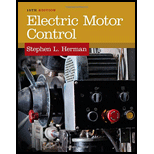
Concept explainers
What is the purpose of inserting resistance in the stator circuit during starting?
Explain the reason of inserting a resistor in a motor stator circuit.
Explanation of Solution
A resistor is inserted in a motor stator circuit in series. The voltage drop caused by inserting resistor reduces the voltage across the motor terminals. Reduced voltage results in reduced starting torque and reduced inrush current. Therefore, the resistor is inserted in stator to reduce the starting voltage of a motor and to avoid the winding damages.
Example:
Refer to Figure 26-1 in the textbook where the supply voltage of 480 V is connected across the resistor and the motor which is connected in series. The resistor voltage drop causes the low voltage
Conclusion:
Thus, the reason for inserting a resistor in a motor stator circuit is explained.
Want to see more full solutions like this?
Chapter 26 Solutions
Electric Motor Control
- NO AI PLEASE WILL REJECTarrow_forwardCalculate A, B, C, and D constants, sending end voltage and sending end current of a 3-phase, 50-Hz overhead transmission line 100 km long has the following constants Resistance/km/phase = 0.1, Inductive reactance/km/phase 0.20, Capacitive susceptance/km/phase = 0.04 x 10 siemen. when supplying a balanced load of 10,000 kW at 66 kV, p.f. 0-8 lagging. Use nominal T method. andarrow_forwardDon't use ai to answer I will report you answerarrow_forward
- 14:00 APP Voi) 5G 鼷浴醵郯興47% atheva.cc/index/index/index.html The Most Trusted, Secure, Fast, Reliable Cryptocurrency Exchange Get started with the easiest and most secure platform to buy, sell, trade, and earn Cryptocurrency Balance:1000.00 Recharge Withdraw Message About us BTC/USDT ETH/USDT EOS/USDT 83259.00 1841.46 83259.00 +1.02% +0.08% +1.02% Operating norms Symbol B BTC/USDT Latest price 24hFluctuation 83259.00 +1.02% ETH/USDT 1841.46 +0.08% B BTC/USD illı 83259.00 +1.02% Home Markets Trade Record Mine О <arrow_forwardPastner Brands is a calendar-year firm with operations in several countries. As part of its executive compensation plan, at January 1, 2024, the company issued 480,000 executive stock options permitting executives to buy 480,000 shares of Pastner stock for $38 per share. One-fourth of the options vest in each of the next four years beginning at December 31, 2024 (graded vesting). Pastner elects to separate the total award into four groups (or tranches) according to the year in which they vest and measures the compensation cost for each vesting date as a separate award. The fair value of each tranche is estimated at January 1, 2024, as follows: Vesting Date Amount Fair Value Vesting per Option: December 31, 2024 25% $ 3.90 December 31, 2025 25% $ 4.40 25% $ 4.90 25% $ 5.40 December 31, 2026 December 31, 2027 Required: 1. Determine the compensation expense related to the options to be recorded each year 2024-2027, assuming Pastner allocates the compensation cost for each of the four…arrow_forwardJOB UPDATE Apply on- Jobswood.com OR Search "Jobswood.com" on Google COMPANY JOB PROFILE JOB LOCATION WEB ENGINEER GOOGLE MULTIPLE CITIES (FRESHERS) AMAZON SOFTWARE DEV ENGG MULTIPLE CITIES COGNIZANT SYSTEMS ENGINEER CHENNAI ZENSAR FRONTEND DEVELOPER BENGALURU ORACLE AUTOMATION ENGINEER BENGALURU DIGITAL OCEAN SUPPORT ENGINEER HYDERABAD IBM APPLICATION DEVELOPER HYDERABAD INDIAMART WORK FROM HOME MULTIPLE CITIES AMAZON RECRUITER HYDERABAD GE HEALTHCARE TRAINEE ENGINEER BENGALURUarrow_forward

 Delmar's Standard Textbook Of ElectricityElectrical EngineeringISBN:9781337900348Author:Stephen L. HermanPublisher:Cengage Learning
Delmar's Standard Textbook Of ElectricityElectrical EngineeringISBN:9781337900348Author:Stephen L. HermanPublisher:Cengage Learning Electricity for Refrigeration, Heating, and Air C...Mechanical EngineeringISBN:9781337399128Author:Russell E. SmithPublisher:Cengage Learning
Electricity for Refrigeration, Heating, and Air C...Mechanical EngineeringISBN:9781337399128Author:Russell E. SmithPublisher:Cengage Learning


